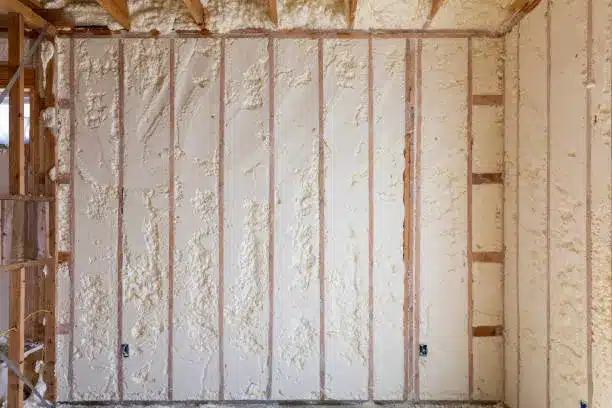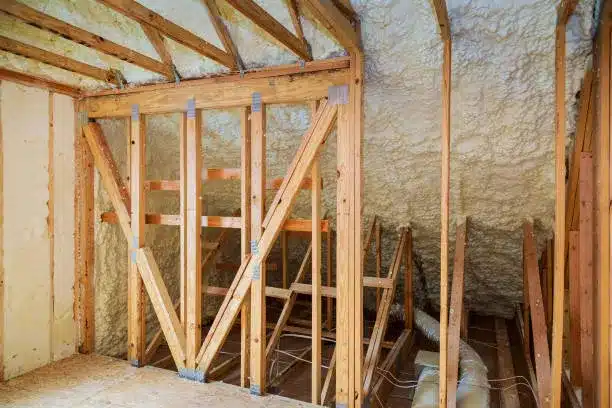Spray foam insulation is one of the best upgrades you can make for energy efficiency, air sealing, and comfort. But when it comes time to choose the right kind of spray foam, many homeowners hit a roadblock: open-cell or closed-cell spray foam—what’s the difference, and which one is right for your space?
At All Foam & Insulation, LLC, we’ve been installing both types of spray foam in homes and commercial buildings across Oregon for years. This guide breaks down what you need to know—without the jargon—so you can make an informed decision based on your budget, space, and performance goals.
What Is Spray Foam Insulation?
Spray foam starts as a liquid and quickly expands when applied, filling cracks and sealing off air leaks better than traditional fiberglass or cellulose. It creates a tight thermal envelope that holds in heat during winter and keeps it out during summer—something especially important in Oregon’s variable climate.
There are two main types:
- Open-cell foam, which is lighter, softer, and more flexible
- Closed-cell foam, which is denser, stronger, and acts as a moisture barrier
Both are great solutions when installed properly—but they’re used for different reasons in different parts of a building.
Open-Cell Spray Foam: Pros and Best Uses
Open-cell spray foam is made of tiny bubbles that aren’t fully sealed. This makes the foam more breathable and less rigid.
Why Homeowners Like It:
- Expands more: Great for reaching into tight or irregular cavities
- Cost-effective: Less expensive than closed-cell
- Sound control: Absorbs sound better, making it ideal for interior walls
Best Applications:
- Attics and rooflines
- Interior walls for sound dampening
- Renovation projects where walls are open
Open-cell foam works well in areas that need to breathe and don’t deal with a lot of moisture.
Closed-Cell Spray Foam Explained: Benefits and Where It Works Best
Closed-cell foam contains sealed bubbles that are packed tightly together, making the foam much more rigid and resistant to air and moisture.
What Makes It Stand Out:
- Higher R-value: About R-6.5 per inch
- Moisture barrier: Keeps water out, reducing risk of mold
- Adds strength: Can make walls and roofs stronger
Best Applications:
- Crawlspaces and basements
- Pole barns and metal buildings
- Exterior walls, especially in wet or windy zones
Use closed-cell foam in any area prone to moisture or needing additional structural support.
Key Differences Between Open and Closed-Cell Spray Foam
| Feature | Open-Cell Foam | Closed-Cell Foam |
| R-Value (per inch) | ~3.5 | ~6.5 |
| Moisture Barrier | No – vapor permeable | Yes – blocks moisture and vapor |
| Cost | Lower upfront cost | Higher material and labor cost |
| Expansion Rate | Expands up to 100x | Expands 30x or less |
| Best For | Attics, interior walls, soundproofing | Basements, crawlspaces, exterior walls |
How to Choose the Right Spray Foam for Your Project
Start by asking what the space demands:
- Is the area exposed to moisture or temperature swings? Go with closed-cell.
- Do you need help with noise between rooms? Open-cell is better.
- Is budget a big concern? Open-cell is more affordable.
- Are you short on space? Closed-cell gives more R-value per inch.
Cost Comparison: What to Expect
Spray foam isn’t the cheapest insulation out there—but it pays off in energy savings and comfort.
- Open-cell: Roughly $0.45–$0.75 per board foot
- Closed-cell: Typically $1.00–$1.50 per board foot
Closed-cell foam may cost more upfront but can prevent moisture damage and improve structural integrity—saving money in the long run.
Which One Offers Better Energy Efficiency?
Closed-cell wins in raw R-value—offering nearly twice the insulation per inch compared to open-cell. That makes it ideal for areas where space is tight and performance is critical, such as rim joists or under metal roofs.
Moisture Resistance & Vapor Barriers: What You Should Know
One of the biggest differences between these two types is how they handle water. Closed-cell foam repels moisture and is often used as a vapor barrier. Open-cell lets vapor pass through—great for attic spaces but not for basements or crawl spaces.
Additional Considerations
Noise Reduction Capabilities
Open-cell is superior at sound dampening. It’s the go-to for media rooms, bedrooms, and shared walls.
Structural Strength
Closed-cell foam can stiffen wall systems and even help meet structural requirements in some cases—adding up to 300% more strength in certain assemblies.
Installation Areas
- Open-cell: Attics, interior walls, vaulted ceilings
- Closed-cell: Foundations, roofs, crawlspaces, exterior walls
Indoor Air Quality
Both types help by sealing out allergens, but professional installation is critical to ensure safety and proper ventilation.
Building Code and Climate Zones
In colder zones of Oregon, closed-cell may be necessary to meet insulation code minimums. Always check with a contractor who knows your region.
Insulation Lifespan
Both products are long-lasting, often performing well for over 20 years with no need for replacement.
Ready to Choose the Right Spray Foam?
Whether you’re insulating a new home, finishing a remodel, or solving an energy leak in your crawlspace, the choice between open-cell and closed-cell spray foam depends on your building’s needs. Both types are excellent—when used in the right place.
If you want help figuring out what’s best, let the experts at All Foam & Insulation, LLC take a look. We’ll walk your space, explain your options, and provide an honest estimate with no pressure.
📞 Call now: (541) 826-9600
📧 Email: [email protected]
🌐 Visit: https://allfoamandinsulation.com
Frequently Asked Questions
What is the main difference between open-cell and closed-cell spray foam?
Open-cell is soft and breathable. Closed-cell is dense, waterproof, and more insulating.
Which spray foam is better for attics?
Open-cell works for ventilated attics. Closed-cell is better in unvented or cold climates.
Is closed-cell foam worth the higher cost?
Yes—especially where moisture, strength, or R-value is a priority.
Can I use open-cell foam in a basement?
Not recommended. Use closed-cell where there’s a risk of moisture.
Does spray foam insulation prevent mold?
Closed-cell foam blocks moisture and helps stop mold. Proper installation is key.
Which foam is better for soundproofing?
Open-cell, hands down.
What’s the R-value of each type?
Open-cell: ~3.5 per inch. Closed-cell: ~6.5 per inch.





